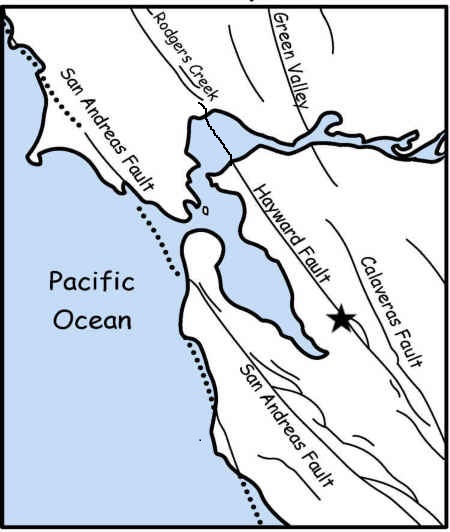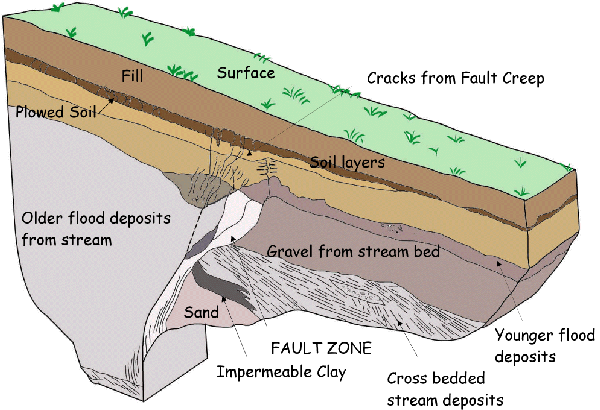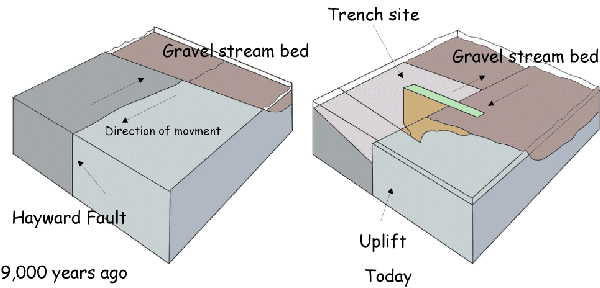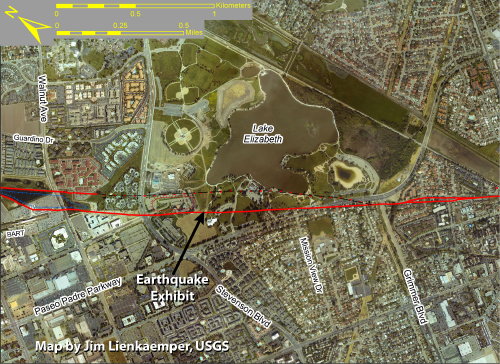Math Science Nucleus
The success of the Fremont Earthquake Exhibit (The Hayward Fault Exposed, April – Oct, 2006) warrants developing a strategy for preserving the exhibit. The Math Science Nucleus, who is currently managing the exhibit in cooperation with the City of Fremont and the U.S. Geological Survey, has concluded that the educational value to school groups and the general public is high. An informational kiosk could allow visitors to take an exciting tour of the Hayward’s Fault surface features in the Central Park. Visitors can visually see the effects of fault movement that educates them on why they should be prepared. The Math Science Nucleus would also like to develop engineering plans and long term use of a permanent exhibit. This type of Earthquake Exhibit could attract people from all over the country. After preliminary talks with professionals we have concluded that an exhibit is possible in the area. However, because the exhibit would be on the fault, the scope and breadth of the exhibit needs to be determined. Background Over 20,000 people are projected to visit the Fremont Earthquake Exhibit over six months. The typical reaction after visiting the exhibit is one of appreciation and fascination at the opportunity to see an earthquake fault and to receive up-to-date information on earthquakes. They appreciate learning about earthquake preparedness. School children who visit in groups are generally ‘wowed’ by the continuous fault creep. Seeing the offset curbs next to the exhibit make the children see the earth is ‘alive’ and active. Thinking about what happens during earthquakes, and why, sparks their interest and only enhances their impression of science. The Fremont Earthquake Exhibit closed on October 30, 2006 because of engineering problems during the rainy season and state building codes on temporary exhibits. It was determined that it would be cheaper to cover the trench and reopen it at a later date, then to continue it during the rainy season. The figure below shows that the entire area of the original Fremont Earthquake exhibit would provide an exposure that would be as exciting as the original. There is great interest in continuing the experience and many involved would like to develop a permanent Earthquake Exhibit. A permanent exhibit also fits into the goal of the Math Science Nucleus, to increase science in schools and the public. Why create a permanent Fremont Earthquake Exhibit? · It would be the only exhibit in the United States that enables visitors to see an earthquake fault below the surface and in three dimensions. · An exhibit could allow residents to locate where their house is from the fault trace · The exhibit works to debunk many common myths and reminds people that earthquakes cause disasters but also created our area’s scenic beauty. · Earthquakes are a part of life in California. · Earthquakes fascinate but can frighten. The exhibit encourages visitors to be prepared, not just scared. · Educators from University to K-12 schools can take a self-guided field trip, especially with an appropriate kiosk and markers. The students learn about earthquakes and science but also the importance of personal responsibility and safety.
A Plan for the Future (November 2006-October 2007) The Math Science Nucleus proposes that one kiosk and several small markers that would help school groups and the community to take a walking tour of the surface features. The kiosk would provide information explaining the Hayward Fault traces in Central Park and vicinity. A trail may be constructed that would help bring people through the area easily. The kiosk and small markers would be coordinated by the Math Science Nucleus in collaboration with City of Fremont and U.S. Geological Survey. The information provided will include details on a walking tour and how to prepare for earthquakes. The walking tour would include the major surface features that you see today throughout the park. We have developed a walking tour that goes from Tule Ponds at Tyson Lagoon Wetland Center (a 17 acre Alameda County owned facility that the Math Science Nucleus manages) to Stivers Lagoon (part of Central Park). This represents over 2 miles of features that can be divided into several components. The walk includes both traces of the Hayward Fault. Participants walk through the area and see features that are caused by fault creep and to compare them to features that are not.
In the first year we will develop and erect the kiosk and markers to coincide with the Hayward Fault Guide Book that we developed. We would work with the City to determine were the kiosk and markers could be placed that would not add any maintenance to city staff. We would use the fault trail to provide free classes to bay area schools and universities. We would also plan and develop engineering and design plans for a Fremont Earthquake Exhibit that the City of Fremont would approve. The exhibit we are planning would be modest and similar to the present structure, but would be year round and would conform to city and state regulations. We would like to reopen the exhibit on October 21, 2008 which would be the 140th anniversary of the 1868 Earthquake which devastated the east bay with a large (6.8-7) earthquake. We would use funds from this proposal to developing a funding revenue for the exhibit. The current operator of the exhibit is the Math Science Nucleus (MSN), a non-profit educational organization located in Fremont, California. The MSN needs the cooperation of partners in order to successfully operate a quality exhibit. Cooperation between technical organizations, engineering groups, exhibit designers, and the MSN is crucial. Throughout the year Nucleus staff will develop a working group to discuss engineering, scientific, and public use of the exhibit. Maintenance of the kiosk needs to be incorporated within the scope of this project. We feel that grants may be available or even tours can generate funds. Grants for public safety and education could provide a revenue source as well. Long term maintenance will be incorporated into the final engineering plans to make sure that this project is successful. Budget 1. Because the kiosk and markers will be custom-made, a cost may range from $10,000 - $100,000 depending on the size and whether it includes virtual components and how many. We need to work with the city staff to determine funds for permitting whether we need sidewalks around the area; change of sprinkling system, and other engineering details. Staff time about $10,000; permits and city staff time $5,000. Total budget: $115,000 2. Working with U.S. Geological Survey scientist (Dr. David Schwartz) to determine the best place (geologically) to erect a permanent exhibit. This would include the area just to the northwest of the present exhibit, which might be more desirable to the city. This may include 5 trenches at $1000 each; staff time of $10,000. USGS staff time is donated. Total $15,000.00 3. Math Science Nucleus staff is needed to continue developing tours, contract out to builders and engineering firms to design kiosk, oversee installation of kiosk, providing tours using the kiosk, and grant writing. Field trips would be free to school groups (about 100 per year), educational presentations to funders, etc (1 year salary part time –full time + benefits $25,000 - $62,000 per year) Total $62,000.00 4. Engineering plans for permanent exhibit ($20,000 - $25,000) (for geotechnical firm) and $30,000 - $40,000 for architectural plans with city approval; MSN staff time to work engineering and design groups $10,000.00; city staff time to work with engineers $5,000.00. Total: $80,000.00 Total to get 1 year of educational field trips, kiosks, engineering plans, permits, fundraising for permanent exhibit: $272,000.00 |




